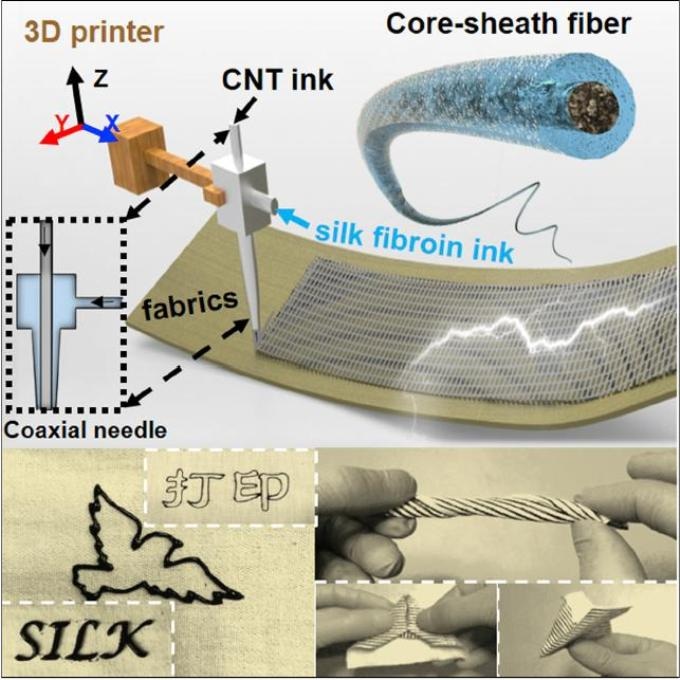Mar 28 2019
The development of wearable electronic devices can possibly be superior to smartwatches. However, the existing choices for circuit boards and battery packs cannot form the most convenient E-socks. One way to solve this is by only printing flexible fibers on transitional textiles or clothes, which has been developed by researchers in China.
 This visual abstract depicts the work of Zhang et al.: A facile one-step fabrication of coaxial fiber-based smart patterns for E-textile through 3D printing equipped with a coaxial spinneret is reported. Versatile smart textiles for different purposes can be fabricated by selecting different materials in the construction of the coaxial layers. Examples such as silk energy-harvesting textile and energy-storage textile with superior performance are demonstrated. (Image credit: Yingying Zhang/Matter)
This visual abstract depicts the work of Zhang et al.: A facile one-step fabrication of coaxial fiber-based smart patterns for E-textile through 3D printing equipped with a coaxial spinneret is reported. Versatile smart textiles for different purposes can be fabricated by selecting different materials in the construction of the coaxial layers. Examples such as silk energy-harvesting textile and energy-storage textile with superior performance are demonstrated. (Image credit: Yingying Zhang/Matter)
For instance, the researchers printed patterns capable of collecting and storing electricity on the fabrics. Using a 3D printer provided with a coaxial needle, they drew pictures, patterns, and lettering on the cloth, making it capable of converting movement into energy. The development has been reported in Matter, a new materials science journal from Cell Press, on March 27th, 2019.
We used a 3D printer equipped with a home-made coaxial nozzle to directly print fibers on textiles and demonstrated that it could be used for energy-management purposes. We proposed a coaxial nozzle approach because single-axial nozzles allow only one ink to be printed at a time, thus greatly restricting the compositional diversity and the function designing of printed architectures.
Yingying Zhang, Study Senior Author, Professor, Department of Chemistry, Tsinghua University.
Zhang and her team developed their first 3D-printed E-textiles by making use of two inks—a carbon nanotube solution to form the conductive core of the fibers and silkworm silk for the insulating sheath (even though other laboratories could select materials that could be adapted for biocompatibility, flexibility, and waterproofness).
Injection syringes containing the inks were attached to the coaxial nozzle, which was fastened to the 3D printer. These have been used to draw customer-modeled patterns, like the English word SILK, Chinese characters meaning PRINTING, and an image of a pigeon.
This technique is different from the others where sewing of electrical components on fabrics is done manually, like LED fibers. However, these processes involve many stages and are labor-intensive and time-consuming. The advantage of using a 3D printer is that it could develop versatile features on fabrics in just one step. The method costs low and is easy to scale because the nozzle has been found to be appropriate for the current 3D printers, and the parts can be replaced. However, one disadvantage is that the determination of what could be printed is restricted to the mechanical movement accuracy of the 3D printer and nozzle size.
We hope this work will inspire others to build other types of 3D printer nozzles that can generate designs with rich compositional and structural diversity and even to integrate multiple co-axial nozzles that can produce multifunctional E-textiles in one-step. Our long-term goal is to design flexible, wearable hybrid materials and electronics with unprecedented properties and, at the same time, develop new techniques for the practical production of smart wearable systems with integrated functions, such as sensing, actuating, communicating, and so on.
Yingying Zhang, Study Senior Author, Professor, Department of Chemistry, Tsinghua University.
This study was funded by the National Natural Science Foundation of China, the National Key Basic Research and Development Program, and the National Program for Support of Top-notch Young Professionals.